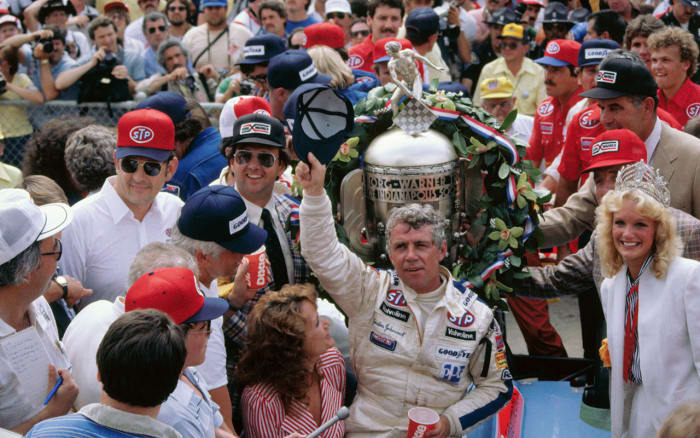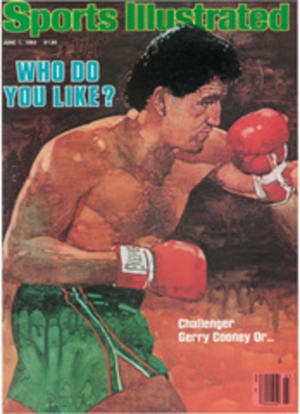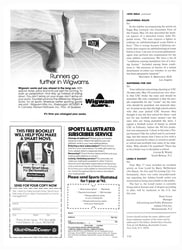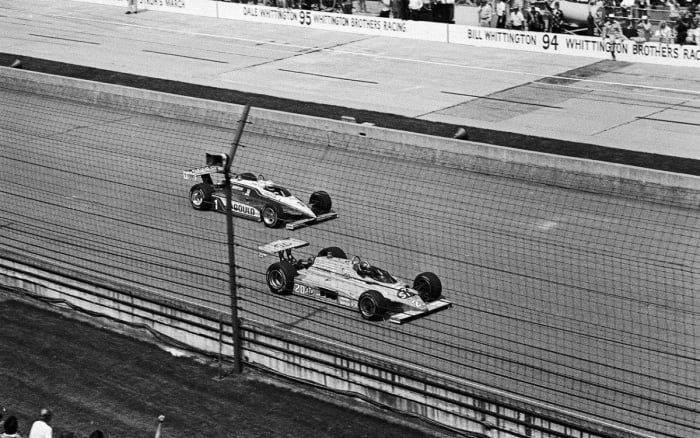Wee Gordy Wins Big
All along the Indianapolis Speedway's Gasoline Alley there is a cast-in-concrete image of Gordon Johncock: a shy, likable little guy, one people are perpetually rooting for but only halfheartedly, because they know to wish too hard for Johncock to succeed is an exercise in frustration. He's hopelessly unlucky. If something can go wrong, it's sure to go wrong for Wee Gordy. Still, the sentiment and respect are undeniable. He's admired because he drives with his heart.
With 13 laps remaining in the 1982 Indy 500, Johncock was leading the race, having gotten there largely on heart. For the first 155 laps his STP Wildcat-Cosworth hadn't handled well at all, and he had had to wrestle it every mile of the way. Somehow he had kept the car in contention. Then, from Lap 155 to Lap 187, the Wildcat had turned perfect on him, and Johncock had moved from fourth into the lead, past Rick Mears, the heavy favorite, driving a Penske-Ford, whose 207-mph qualifying speed made it the fastest car in the history of the Brickyard. Now, after holding Mears off and gaining a few seconds in the pits, Johncock led by 12 seconds.
A 12-second lead with 13 laps to go is a big one for most people. But the 5'7" Johncock isn't most people and he, more than any of the 400,000 witnesses to this sprint to the checkered flag, knew it. Almost predictably, Johncock felt the handling of his car begin to deteriorate again. His left rear tire was overheating, causing it to expand and thus make the car "push" through the turns. Mears began to close on Johncock at the rate of one second per lap.
"I was running as hard as I could go," he said later. "I was looking in my mirror every lap and I could see Mears coming. I thought, 'Yep, here it is again.' "
Johncock had lost so many 500-mile races near the finish to bad luck—blown tires, dry gas tanks—that he had a right to feel the way he did. The more his car pushed, the bigger Mears loomed in his mirror. Johncock began thinking about the 1977 500, which he was leading by four seconds with 16 laps to go when his engine swallowed the crankshaft. The sight of Johncock standing hot and forlorn in an infield drainage creek as A.J. Foyt took the checkered flag aptly symbolized his fate at the Brickyard. "I started thinking about that '77 race with about 10 laps to go, especially when the car started pushing a lot," he said. "It just seems that throughout my career it hasn't been meant for me to run 500 miles."
With four laps remaining, Mears had pulled to within three seconds of Johncock. Both Mears's Penske crew and Johncock's Patrick team were frozen in suspense as the high-speed drama played out around them. With two laps left, Johncock's lead was .8 of a second. As they came down the front straight to take the white flag signaling one lap to go, Mears nosed up beside Johncock. "When I saw him coming up alongside me I thought, 'Well, that's all she wrote,' " said Johncock. "But I knew I would've gone into the first turn side by side with him because there was no way I was going to back off."
Because Johncock had the outside line into the turn, the better line, Mears had to back off and tuck in behind him. That was the last time Johncock saw Mears. "I had my hands so full I really didn't have time to look for him," Gordy said. "I was driving as hard as I could. The car was pushing so bad I had to drive all the way down to the bottom of the turns to keep it from pushing up into the wall. On the last lap, in Turn 3, I almost lost it; all four tires were below the white line."
Coming off the final turn, Mears chased Johncock down the straight toward the checkered flag. Mears swung out in a final, desperate attempt to slingshot past, but Johncock crossed the finish line slightly more than a car length ahead. As measured by the clock his margin was .16 of a second. It was the closest finish, and perhaps the most exciting, in the 66-year history of the 500.
Officially it was Johncock's second Indy win, but he doesn't count the first, which came in 1973. Johncock isn't alone—that was a race a lot of people would like to forget. But until last Sunday it typified Johncock's career at the Speedway. That race was postponed for two successive days because of rain. On the third day, it was finally run, but called at 332.5 miles, again because of rain, with Johncock in the lead. Thus he was the winner. In that race Johncock's teammate, Swede Savage, was fatally injured, as was Armondo Teran, one of the STP crewmen, who was hit by a truck on pit road as he ran toward the fiery car in which Savage was trapped. Safety crews cut Savage free. He died 33 days later.
To many, that race never really ended. There was a feeling that it had been called because of emotional fatigue rather than rain. As Johncock received the trophy hardly anyone was there to cheer him, most of the spectators having gone home. No one even wanted to bother with a victory banquet that year. Then Johncock's $90,000 slice of the $236,000 purse was withheld by a Federal bankruptcy referee, most of it to be divided among his creditors and his first wife and five children. At the time, his second wife was suing him for divorce.
But that was nine years ago. As Johncock rolled into Victory Lane Sunday his car was festooned with exuberant crewmen. This time there were plenty of cheers. "There will never be another thrill like this," Johncock said as he stood shyly beaming, and you knew it was true.
It was an enormously satisfying finish to a race that had begun as if it might turn into another Indy disaster. As the field came off the fourth turn toward the green flag for the start, Mears's teammate, Kevin Cogan, starting in the middle of the front row, suddenly veered to the right—into A.J. Foyt, who was on the outside pole. The Penske racer bounced off Foyt's March and spun across the 50-foot-wide front straight, hanging there sideways with 30 cars—20,000 horsepower—and adrenaline-filled drivers charging straight at him. Mario Andretti was the unfortunate driver behind Cogan; he had no chance of avoiding him, and Andretti's Wildcat nailed Cogan dead center. Cogan hit the inside wall and then caromed across the track to the outside wall, while Andretti's car—a duplicate of teammate Johncock's—slid backward down the front straight. Behind them, 22-year-old rookie Dale Whittington came sailing into the confusion from his eighth-row starting position and drove into the back end of Mears's brother Roger's car, knocking them both out of the race. Which hadn't even begun.
Cogan and Andretti left their cars and stepped over the low safety wall between the track and the pits. Andretti, the winner of the 1969 500 and a former world Grand Prix champion, said something brief to Cogan, emphasizing it with a quick shove of disgust, then walked away. Cogan removed his helmet and followed Andretti, gesturing plaintively with his free hand. Andretti was too furious to have any of it; he continued to stomp toward Gasoline Alley.
Then Foyt appeared, and now it was his turn to yell at the 26-year-old Cogan. Still shaken by the mishap, Cogan looked at Foyt, the four-time Indy winner and its most famous driver, a bit glassy-eyed.
"A.J.," he said, trying to interrupt Foyt's tirade, "I don't know what happened."
"Why'd you do it?" Foyt shouted.
"I don't know what happened," Cogan repeated.
Foyt wheeled and stalked off.
Andretti ran up to Roger Penske, for whose team Mears and Cogan were driving, and shouted something about Cogan's inexperience—he had raced at Indy only once before.
Followed to his garage door by reporters, Cogan was asked what Foyt had said to him. He replied, "I'd rather not say."
Cogan's wasn't an enviable position. So much pressure had been on him all month. Here was a young driver who had taken the celebrated Mario Andretti out of the race and had come close to doing the same thing to the renowned A.J. On the pace lap!
But he handled the situation well. "I'm not sure what happened," Cogan said. "The rear of my car went to the left and the front went to the right. It felt like someone hit me from behind." Then he went inside his garage and closed the doors, not to say anything further until the car could be examined.
Said Andretti angrily: "He was doing exactly what he wasn't supposed to do. He crowded Foyt. There's just too much pressure up front. Cogan couldn't handle the responsibility of the front row. Penske has a car that's just too good for its driver."
Andretti was convinced that Cogan had been in first gear when he should have been in second. He suggested that when Cogan accelerated and the turbo-charger kicked in, the added torque in first gear twisted the car to the right, into Foyt. Cogan denied he had been in first gear. He was convinced that something had broken on the car. As the race went on without him, and as Andretti continued to denounce him on TV, Cogan remained behind the closed garage doors.
Penske mechanics went grimly in and out of the garage, and one could hear the hammering and clanking sound of the car being dismantled for an autopsy. The race had been going on for a full 30 laps when Cogan finally came out, wearing neatly pressed jeans and a T shirt and looking as if nothing had happened. "We found what broke," he announced calmly. "It had nothing to do with me." He explained that a constant-velocity joint on the right rear axle had snapped, which had caused the car to swerve suddenly to the right. "That's it for sure," he added.
But it wasn't quite that final. Penske, though expressing complete confidence in his driver, and disappointment at Andretti's attack, was careful not to claim that the broken CV joint had caused the accident. Penske allowed the possibility that the broken joint might have been a result of the crash. Most likely, the truth will be forever in doubt. It's a burden Cogan will have to live with, maybe until he wins the 500. Johncock could tell him about living with such burdens.
Fifty-three minutes after Cogan's mysterious and costly swerve, the race started for real. Foyt, whose left front steering tie rod had been bent in the brush with Cogan and had been replaced, sped into the lead, with Mears in second. Johncock was third, Tom Sneva fourth. For the first 35 laps they stayed mostly that way. Mears, who rarely chooses to lead early in 500-mile races anyway, was following Penske's orders: Don't get in any dogfights. He was confident he had the best car, and could save top performance until he needed it. On the 60th lap he used some to take the lead from Sneva. Foyt was beginning to have gearbox trouble. He finally pitted on lap 95 with the car stuck in gear; when his mechanics couldn't fix it he first fumed, then climbed out of the car and began banging at the shifting arms with a small sledge and a big screwdriver. He gave them a few hearty whacks, more in frustration than any serious attempt to fix the car. So ended Foyt's 25th 500.
On the 95th lap Johncock took the lead after a pit stop under a yellow flag. Mears came out of the pits behind him and Johncock fought him off for 13 laps: It would be a preview of their last-laps battle. But then the handling of Johncock's Wildcat deteriorated, and he dropped to fourth. Mears led for the next 50 laps until Gordy could overtake him again.
On lap 160 there began exactly 100 of the best racing miles the Speedway has ever seen. Johncock's car had finally begun to handle the way it should. As he dueled with Mears and Sneva, whose hopes were to be dashed by an overlong pit stop and ultimately a blown engine, the crowd rose and began cheering mightily for the underdog.
Mears made his final pit stop on lap 183. As he came screaming into the pits, he had to lock his brakes in an attempt to avoid hitting Herm Johnson's car, which was slowly making its way down pit road. He actually bumped into Johnson. The Penske crew took 19 seconds to fuel Mears but they didn't change tires despite the possibility they had been flat-spotted in the pit road incident. Johncock blasted in for a final pit stop on the next lap; he too found a car dawdling in front of him, but Johncock got by cleanly on the left. His crew, chiefed by George Huening, took only 13 seconds to get him back out again. That would be decisive.
Johncock came out of the pits with that 12-second lead and the bad "push," and Mears emerged charging, cutting 198-mph laps as he tried to chase Gordy down. Johncock was using all of the race track, driving like a man possessed. Mears gave it his best shot, but he ran out of time. "Man, I could have used one more lap," he said later. Then he went looking for Johncock and found him in the STP garage. Mears came in grinning, shouting, "Where is that short little son of a bitch?"
Penske handsomely took the blame for his driver's defeat. The race had been won in two places: Turn 1, when Johncock held Mears off, and in the pits, when the Patrick crew had beaten the Penske crew by those six seconds. "My fault," said Penske. "We miscalculated the rate of fuel flow. We ended up filling up the tank, and we didn't need to. We simply kept Rick in the pits too long."
As for Johncock, he'd been gone from Victory Lane too long. There had been something different about him this year. At 45, with 27 years of racing behind him which had brought only 21 Indy-car victories, he wanted this 500 badly. He was even quieter than usual, more single-minded. He wanted to win the Indy 500 the right way, to set the record straight. With four cars in the field clearly faster than his, the odds were against him.
But he beat them, and rarely has there been a more popular victory. Johncock had paid for it with a career full of ill fortune. They'll no longer remember Gordon Johncock as the man who won the wrong 500. They'll remember him as the underdog who held off the fastest car in Brickyard history, and in the doing gave us the most marvelous finish in all those 66 years.
TWO
PHOTOS
Johncock pluckily held off Mears all the way to Victory Lane.
TWO
PHOTOS
Cogan's caroming car put Andretti's into the wall, and from there onto the hook of a tow truck, even before the 33-car field got to the starting line.
PHOTO
Foyt blasted Cogan for the botch-up...
PHOTO
...while Andretti laced into Cogan's boss, Penske, for providing too much too soon.
PHOTO
Foyt took matters into his own hands when his transmission seized, but to no avail.
PHOTO
Johncock's winning margin was .16 second, the closest finish in Indy's history.
PHOTO
Mears's long final pit stop doomed the fastest car ever to race at the Speedway.
PHOTO
Penske took blame for messing up Mears.



